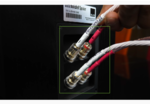Bi-amplifying you speakers will be very helpful when you need to use a really power amplifier for other speakers and sub-woofers. Bi amplifying the speakers involves simple steps of using the RCA splitter to send more than one signal to the speakers. Here is how you can easily Biamp the speakers with an external amplifier.
‘Step 1’
‘Use the RCA splitters for connection’
In order to bi-amplify the speakers, you need the ‘RCA Splitters’ for connection. The RCA splitters will help in sending two signals to each speaker. Make sure any RCA splitter you use have single female and two dual male connectors.
‘Step 2’
Connect the RCA outputs from the AV Receiver’
The first step is to ‘Connect the RCA outputs’ from the AV Receiver. As shown below, the connections are made front left and the front right speakers in the main pre-out section of the AV receiver.
‘Step 3’
‘Connect the two male ends of the splitter’
The next step is to ‘Connect the two male ends of the splitter’ to the ‘first two amplifier inputs’. Make sure to remember which two amplifier inputs you are considering for the left speakers. Similarly notice the ports for the right speakers.
‘Step 4’
‘Connect the second splitter male connector’
Now, ‘Connect the 2nd splitter male connector’ to the 3rd and 4th amplifier inputs which here, is considered as ports for the right speaker. Make sure the wires are plugged in perfectly.
‘Step 5’
‘Connect the speaker wire to the Amplifier’
Now, the next step is very important. ‘Connect the speaker wire to the amplifier’. Make sure to consider the first two outputs for the left speaker and the next two outputs for the right speaker. This must be in sync with the assumption you make in the previous steps.
‘Step 6’
‘Connect the speaker wires to the speaker’
Now, you need to ‘Connect the speaker wires to the speaker’ . Connect one pair of the speaker cable to the low frequency binding posts and connect the other pair of the speaker cables to the high frequency binding posts. Screw the posts to ensure the wires are plugged in perfectly.
‘You can thus easily Bi-amp speakers with an external amplifier by following a series of steps mentioned above’









